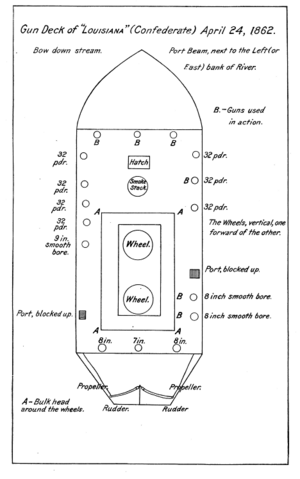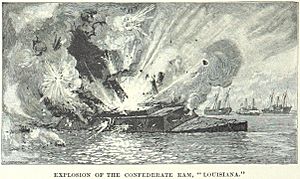CSS Louisiana facts for kids

CSS Louisiana on the way to Fort St. Philip
|
|
Quick facts for kids History |
|
|---|---|
| Name | Louisiana |
| Namesake | State of Louisiana |
| Ordered | October 1861 |
| Laid down | c. 15 October 1861 |
| Launched | 6 February 1862 |
| Commissioned | 20 April 1862 |
| Fate | Set afire by her crew to avoid capture; drifted down Mississippi River, exploded near Fort St. Philip on 28 April 1862 |
| General characteristics | |
| Displacement | 1,400 tons |
| Length | 264 ft (80 m) |
| Beam | 62 ft (19 m) |
| Draft | 12 - 13 feet (3.66 - 3.96 m) |
| Complement | 300 crewmen |
| Armament | 2 × 7 in. (178 mm) Brooke rifles, 4 × 8 in. (203 mm) Dahlgren smoothbore guns, 3 × 9in.(228mm)guns. Seven 32-pounder guns |
The CSS Louisiana was a special kind of warship called a casemate ironclad. It was built for the Confederate States Navy during the American Civil War. Its main job was to help protect the lower Mississippi River from the Union Navy. The Louisiana took part in one big battle, the Battle of Forts Jackson and St. Philip. When that battle went badly for the Confederates, its crew destroyed the ship to keep it from being captured.
Building the Louisiana
Work on the Louisiana started in October 1861. It was built by E.C. Murray in a new shipyard near New Orleans. This ship was unique because it had two paddlewheels and two screws. Each was powered by its own engine. The paddlewheels were placed one behind the other in the middle of the ship. The screws were not for moving forward. Instead, they helped the ship steer in the tricky currents of the Mississippi River.
Building the Louisiana faced many problems. First, there was a shortage of materials, especially iron. The Union Navy's blockade made it hard to get supplies. Also, the Confederate Army needed a lot of the available iron. Getting wood from Florida was also difficult because of the blockade. This forced builders to find other sources.
Workers even went on strike, causing delays. Local militia groups also called workers away for drills and parades. Another ironclad, the CSS Mississippi, was being built nearby. This created competition for skilled workers. Eventually, the builders agreed that Louisiana would get workers first. This meant Mississippi would only progress when Louisiana work stopped. Because of all these issues, the ship wasn't ready to launch until February 6, 1862. This was almost four months after construction began.
The Louisiana in Battle
Soon after the Louisiana was launched, the Union Navy arrived. Their fleet, led by Flag Officer David Farragut, moved into the lower Mississippi River. They threatened the Confederate forts, Forts Jackson and St. Philip. These forts were about 75 miles (120 kilometers) below New Orleans.
On April 16, 1862, Union mortar boats began to set up. They started bombarding the forts on April 18. Confederate generals asked Commander William C. Whittle to bring the Louisiana to the forts. Even though the ship wasn't finished, they needed its help. Whittle agreed, and on April 20, the ship officially joined the Confederate Navy. Commander Charles F. McIntosh became its captain.
At this time, the Louisiana's main engines were installed. But the engines for the steering screws were not. Also, the main engines were not strong enough. The ship could barely move against the river's current. So, it had to be towed down to the forts. Workers were still on board, trying to finish it.
The Louisiana was tied to the riverbank near Fort St. Philip. General Duncan wanted the ship positioned below the forts. But Commander Whittle didn't want to risk the ship. Its deck was not armored, and Union mortars could fire down on it. So, the Louisiana stayed in this spot during the entire battle.
The ship also had other problems. Many of its gun mounts were too high or too low and needed fixing. Workers and their tools filled the gun deck, so the crew couldn't practice with the guns. The crew was also incomplete. Soldiers from the forts had to be brought in to help operate the cannons.
After almost a week of bombing, Farragut decided it wasn't working. So, on the night of April 24, his fleet sailed past the forts. Because of where the Louisiana was tied, it couldn't use all its guns. It couldn't fire from its back or its left side. We don't know exactly how much the Louisiana helped in the fight. General Duncan said it might have fired as few as twelve shots.
However, Union reports show that it did fight at least one ship, the USS Brooklyn. Three shots from the Louisiana went right through the Union ship. But the shots fired back by the Union ship bounced off the Louisiana's armor. The armor worked well! Only three men were killed on the Louisiana. They were all in exposed areas. One of them was the captain, Commander McIntosh.
The Louisiana's Destruction
Once the Union fleet had passed, the Louisiana had no more part in the battle. Its future depended on the forts. The forts were preparing for an attack by the Union army, led by Major General Benjamin Butler. However, on April 28, the soldiers in Fort Jackson rebelled. They forced both forts to surrender to Commander David Dixon Porter.
The naval officers on the Louisiana were not part of these surrender talks. So, they didn't feel bound by the truce. While discussions were happening, they decided not to let their ship be captured. The Louisiana was set on fire, and its crew went ashore. The flames soon burned through the ropes holding the ship. It then drifted down the river. When it was near Fort St. Philip, the fire reached its ammunition storage. The ship exploded with a huge blast, killing a soldier nearby.
Why the Louisiana Wasn't Perfect
Commander John K. Mitchell, who was second in command, explained some of the Louisiana's problems. He wanted to show that the Confederate Navy wasn't to blame for the forts' failure. Here are some of the issues he pointed out:
- The way the paddlewheels were set up meant the back wheel was always in the water churned by the front one. This wasted its power.
- This churning water also made it impossible to steer the ship properly.
- The openings for the guns were too small. This meant the guns couldn't be aimed up or down, or side to side very much. So, the ship had to fight very close to the enemy. Its guns could only aim in a small 40-degree area.
- The gun deck was very hot in the summer, especially when the boilers were running. It was almost impossible for the crew to work there.
Today
The remains of the Louisiana are still at the bottom of the Mississippi River. In November 1981, the NUMA found its location using magnets. You can find more information about the search here.



